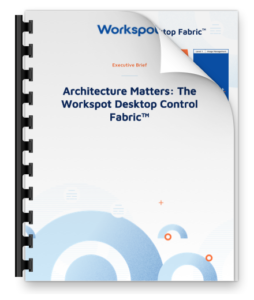The Trouble with VPNs & VDI for Remote Work
For Remote Working, VPNs & VDI Present Serious Challenges
The COVID-19 pandemic forced organizations to take immediate action to support remote work. So many people thought it would be a short term transition, that solution analysis from a long-term perspective didn’t really enter the picture in many organizations – understandably so. As the virus has persisted, people have not only become accustomed to working remotely (and come to value it for the flexibility it brings), but reports directly from our customers tell us that people have been more productive working from home. In fact, Workspot customers are not just surviving, they are thriving during this time. As a result, it seems clear that many people will continue working from home for the foreseeable future. It’s interesting to think about the scenario where, just as we used to work from home one or two days a week, perhaps now we will visit the office to connect with our colleagues one or two days per week. As one of the people who is more productive at home, this makes perfect sense to me.
The challenge for IT teams is that in the rush to get people back to productivity, organizations that deployed quick, short-term solutions for remote workers must now consider what will serve business goals and employees alike for the long term. Security, performance and scalability have never been more critical to get right so you have the flexibility needed to grow the business.
What’s the problem with VDI and VPNs?
In a nutshell? The problems are serious: performance and security. Wherever they are located, people need secure access to their applications and data to get their jobs done, yet if app performance is slow when they’re working remotely, by definition the business is going to take a productivity hit. And security is paramount. Any end user computing solution should be governed by a Zero Trust policy. VDI and VPNs just don’t cut it.
User experience is everything
When the number of people working remotely was relatively low, IT could get by with a VPN solution (setting aside the security concerns VPNs introduce for now), because the small number of people working remotely could use their corporate-owned device and establish a secure network tunnel back through the VPN to the corporate datacenter, and then access their applications and data. But suddenly with widespread remote working required, IT teams have really struggled to scale the VPN infrastructure. All that additional traffic strains the VPN, users experience latency, and productivity suffers. Other companies already had VDI in place, which offers better security than a VPN for sure but comes with its own challenges, especially if your organization is distributed across geographical regions. Companies with existing VDI implementations expanded them as fast as they could, but that is no small feat. Even for those who had the resources to send everyone home to a virtual desktop, there’s no getting around the latency that people who are far from the datacenter experience, and that means those users are unhappy and less productive. So, in this story so far we have two scenarios where these solutions might have helped your company survive, but how can they thrive with reduced productivity?
Security is everyone’s top concern
Most large enterprises are moving toward a Zero Trust Security policy, in which everyone – inside and outside the organization – is considered a security risk until proven otherwise. By the way, that includes your virtual desktop vendor – they should not be able to see any of your data! Many organizations are rightly concerned about the security of VPNs. Its very nature gives malware a direct route into the datacenter. Plus, sensitive data can be copied to endpoints and compromised either knowingly or through an honest mistake when that endpoint is lost or stolen. Organizations cannot afford this glaring security risk, so if you had to make do with a VPN to get people working when the pandemic hit, it’s time to consider plan B.
With VDI, security is a whole different story. Many organizations adopted VDI for the very reason that centralizing apps and data in the data center keeps it more secure, and they were right about that. So with VDI, you have pretty good security. Check. But if productivity is suffering, the business can’t grow. Your data might be secure, but if scalability is difficult and expensive, you can’t respond well to new opportunities. Plus, how can you predict how many people will be working remotely 6 months from now or a year from now? How will you avoid over-provisioning or under-provisioning virtual desktops? With VDI your data is more secure, but you lack the agility and flexibility to nimbly dial resources up and down that you’d otherwise have with a modern virtual desktop solution.
The future of desktops is in the cloud
Compared to what’s possible today, VPN and VDI technologies stymie enterprise growth. Neither of these technologies was designed to address the widespread work-from-home scenarios companies are experiencing today – and for the foreseeable future. Today, organizations of all sizes require an end user computing solution that supports the ability to work from anywhere, with little or no intervention from IT. It should be a seamless transition that happens at a moment’s notice; people should be able to simply go home and pick up work where they left off, on whichever device they feel like using.
The good news is that in the cloud era, IT leaders have a modern end user computing solution to consider that replaces VPNs and VDI: Software-as-a-Service (SaaS) virtual desktops. This is different than a Managed Service Provider (MSP) hosting some other vendor’s virtual desktops for you in their datacenter. We call it a cloud PC – it’s a Windows 10 PC in the public cloud that your users access with their favorite device. A SaaS solution makes it simple and elastic for IT to deliver virtual desktops to end users anywhere in the world. By taking advantage of cloud regions globally and managing everything using a single admin console, IT can dramatically simplify their processes and move on to tackling more strategic projects in support of the business’ growth plans. Cloud PCs, because they are placed in the public cloud region closest to the end user, are outstanding performers – latency is typically so low that our customers often tell us users see faster performance than a physical PC! With the right solution, your Zero Trust Security policy is fortified, not compromised.
Addressing the extended remote working timeline
When Gartner surveyed 317 CFOs and finance leaders recently, 74% of them said they plan to shift “at least five percent of their previously on-site workforce to permanently remote positions post-COVID-19.” Nearly one-quarter (23%) plan to convert at least 20% of previously on-site employees into permanent telecommuters. Twitter and Square are just two of the companies that have already announced their employees can work remotely forever. Update: Microsoft has decided to allow employees to permanently work from home as well – it’s definitely a thing, and enterprises need the flexibility to make these kinds of decisions at the appropriate time.
Given the extended timeline of COVID and the huge numbers of people who will likely work remotely full time, it’s time to think about whether your organization is surviving or thriving. Is your end user computing plan sustainable? Will it take your business into the future and drive the ability to achieve your business goals? If you’re skeptical, and if there is an facet of your current end user computing solution that you’re struggling with, it’s time to start the search for a long-term solution. VDI and VPNs are legacy solutions that were never intended to support a large contingent of remote workers, making them unsuitable for today’s needs.
SaaS virtual desktops offer much-needed flexibility and agility to grow the business now and into the future.
Ready to learn more about Workspot? Schedule a demo and we’ll show you how to spin up thousands of cloud PCs across multiple cloud regions in under 5 minutes!



